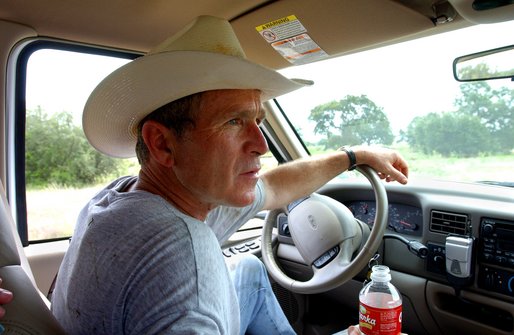George W. Bush, whether you love him or hate him is certainly one of history's most prominent presidents. Marked by the tragedy of 9/11 and the War on Terror, his presidency will certainly be dissected and discussed for many years to come much like his predecessors who faced immense tribulations. Before, during, and after many have taken a look at the man behind the desk, seeing how he lead a nation by day but was determined to remain a regular Texan by night. While John Adams may not have had the monumental events that challenged President Bush, there certainly are many similarities in their personalities and commitment to a rugged life. Many regard that Bush's dedication to his home state of Texas was equally reflected in his dedication, often stubbornness, in his decision making.
The Prairie Chapel Ranch in Crawford, TX was regarded as the "Western White House"; over 18 visits from foreign leaders were held there including Russian President Vladimir Putin and King Abdullah of Saudi Arabia. It's political importance aside, the ranch spoke more of who George Bush was than who he had over for
company. The public liked that the president appeared to be down-to-earth, with a ranch that was nestled in a town more rural than where the average American lived. As Andrea Wulf notes, Adams himself was steadfast to his humble home in Quincy. He was always longing to return to his humble home where he could enjoy the, "Ultimate Object of all my Hopes, Wishes, and Expectations, for myself."(Wulf 101) He "preferred a plainer style. At heart he was a farmer, and unlike the other ambassadors at the courts in Versailles and St. James's... Adams wore sturdy broadcloth."(Wulf 45) Bush was seen often wearing cowboy boots, and was in fact sworn into office in a special pair.
Bush much like Adams was very much glued to a particular image, that of a cowboy to be specific. It was an image that was to influence his style of leadership and his presidency: to be a quick and decisive decision maker, a non-negotiator with those perceived as evil, and "would fight for what was right, would not be swayed by opposition, and would never quit, even when things were going badly."(Hoffman 324-325) Many of us saw this come to fruition in his response to 9/11, the War on Terror, Iraq, and the WMDs. Wulf's description of Adams paints him as a "confrontational, assertive, and direct" man. It made him a perfect compliment to Jefferson's quiet, analytical personality, and an aggressive negotiator for treaties. People may have criticized President Bush for the "cowboy image" being a facade, a clever marketing ploy to capture voters. But perhaps through examination of one of our Founders, we can see that he may be a sincere product of humbler beginnings. Both were certainly prominent presidents that may be overlooked in history for certain flaws, but examining each sheds light to their strengths.
Works Cited:
Hoffman K. Visual Persuasion in George W. Bush's Presidency: Cowboy Imagery in Public Discourse.Congress & The Presidency [serial online]. September 2011;38(3):322. Available from: MasterFILE Premier, Ipswich, MA. Accessed December 3, 2013.
Scherr A. James Monroe and John Adams: An Unlikely “Friendship”. Historian [serial online]. Fall2005 2005;67(3):405-433. Available from: Academic Search Premier, Ipswich, MA. Accessed December 3, 2013.
Harrington W. Dubya and Me: Over the course of a quarter-century, a journalist witnessed the transformation of George W. Bush. (Cover story). American Scholar [serial online]. September 2011;80(4):20-34. Available from: Academic Search Premier, Ipswich, MA. Accessed December 3, 2013.


,_2nd_president_of_the_United_States,_by_Asher_B._Durand_(1767-1845)-crop.jpg)
No comments:
Post a Comment